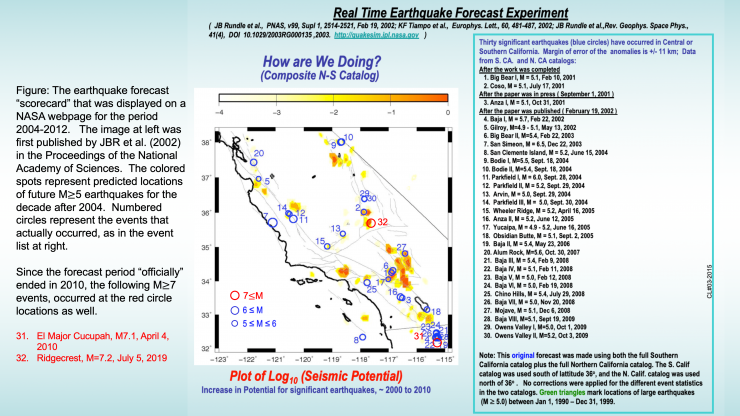Reports on progress in physics the complex dynamics of earthquake fault systems: new approaches to forecasting and nowcasting of earthquakes

John Rundle and colleagues were recently invited to contribute to the prestigious physics journal Reports on Progress in Physics on their work in earthquake forecasting and nowcasting. Charles Richter observed that ‘only fools and charlatans predict earthquakes,’ which reflects the fact that despite more than 100 years of effort, seismologists remain unable to do so with reliable and accurate results. Meaningful prediction involves specifying the location, time, and size of an earthquake before it occurs to greater precision than expected purely by chance from the known statistics of earthquakes in an area. In this context, ‘forecasting’ implies a prediction with a specification of a probability of the time, location, and magnitude. Two general approaches have been used. In one, the rate of motion accumulating across faults and the amount of slip in past earthquakes is used to infer where and when future earthquakes will occur and the shaking that would be expected. Because the intervals between earthquakes are highly variable, these long-term forecasts are accurate to no better than a hundred years. They are thus valuable for earthquake hazard mitigation, given the long lives of structures, but have clear limitations. The second approach is to identify potentially observable changes in the Earth that precede earthquakes. Various precursors have been suggested, and may have been real in certain cases, but none have yet proved to be a general feature preceding all earthquakes or to stand out convincingly from the normal variability of the Earth’s behavior. However, new types of data, models, and computational power may provide avenues for progress using machine learning that were not previously available. At present, it is unclear whether deterministic earthquake prediction is possible. The frustrations of this search have led to the observation that (echoing Yogi Berra) ‘it is difficult to predict earthquakes, especially before they happen.’ However, because success would be of enormous societal benefit, the search for methods of earthquake prediction and forecasting will likely continue. In the review, they noted that the focus is on anticipating the earthquake rupture before it occurs, rather than characterizing it rapidly just after it occurs. The latter is the domain of earthquake early warning, which they do not treat in detail here, although they include a short discussion in the machine learning section at the end.
Earthquake forecast ‘scorecard’ produced and displayed on an NASA web site at the request of NASA program managers. The original map with colored patches was published in 2002 in the Proceedings of the National Academy of Sciences. The small blue circles represent earthquakes that occurred over the subsequent 8 years. The red circles represent the recent M = 7.1 El Mayor–Cucapah, Mexico earthquake on April 4, 2010 (circle 31), and the M = 7.2 Ridgecrest, CA earthquake of July 5, 2019, that occurred well after the evaluation period ended. The results show that the original colored patches calculated in 2001 for the most part identified the location of the future events successfully, with few false positives, as far as 18 years into the future.
Published: October 7, 2021, 8:21 am
